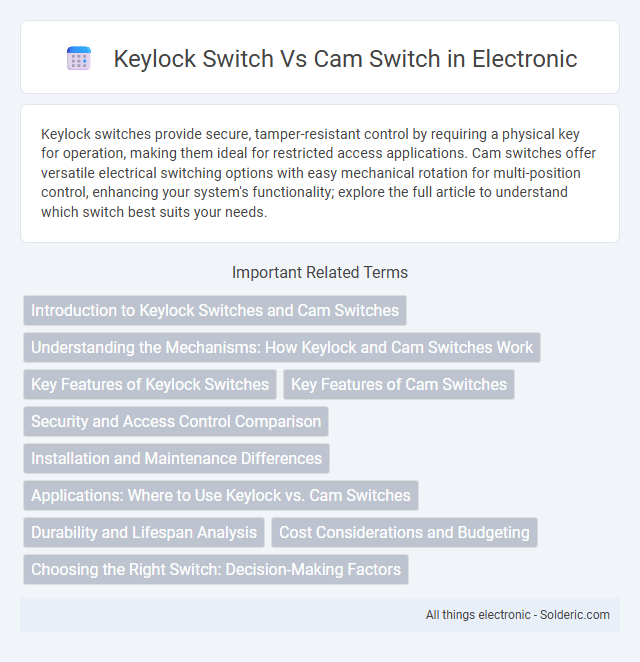Keylock switches provide secure, tamper-resistant control by requiring a physical key for operation, making them ideal for restricted access applications. Cam switches offer versatile electrical switching options with easy mechanical rotation for multi-position control, enhancing your system's functionality; explore the full article to understand which switch best suits your needs.
Comparison Table
| Feature | Keylock Switch | Cam Switch |
|---|---|---|
| Operation | Requires a key to operate | Rotary action using a cam mechanism |
| Security | High security, key control access | Low security, no key needed |
| Applications | Restricted access, safety control | Multi-position switching, industrial control |
| Durability | Robust, tamper-resistant | Durable, suited for frequent switching |
| Installation | Requires key mechanism setup | Simple mechanical installation |
| Cost | Higher due to security features | Generally lower cost |
Introduction to Keylock Switches and Cam Switches
Keylock switches are security-oriented electrical switches that require a specific key to operate, providing controlled access for activating or deactivating circuits. Cam switches utilize a rotating cam mechanism to establish different electrical connections, commonly used for multi-position switching in industrial applications. Understanding your choice between keylock and cam switches ensures the right mix of security and functionality in your control systems.
Understanding the Mechanisms: How Keylock and Cam Switches Work
Keylock switches operate by rotating a key to engage or disengage electrical contacts, ensuring authorized control and preventing unauthorized access. Cam switches utilize a rotating cam mechanism to open or close circuits, offering versatile switching positions for complex control applications. Both mechanisms provide reliable electrical switching but differ in security and operational design tailored to specific industrial and security needs.
Key Features of Keylock Switches
Keylock switches offer secure operation by requiring a unique key to activate or deactivate electrical circuits, preventing unauthorized access and enhancing safety. They feature a durable locking mechanism that maintains the switch position, ensuring consistent performance in industrial and commercial environments. These switches provide reliable control for critical applications such as machinery, security systems, and emergency shutdowns.
Key Features of Cam Switches
Cam switches feature multiple switching positions that enable the control of various electrical circuits with a single actuator. Their robust design supports high current ratings and provides precise, reliable operation in industrial and commercial applications. The modular construction allows easy customization and integration into complex control systems, enhancing flexibility and functionality.
Security and Access Control Comparison
Keylock switches offer higher security by requiring a physical key for activation, ensuring authorized access and preventing unauthorized operation in industrial and electrical settings. Cam switches provide simpler access control through rotary mechanisms but lack the robust security features of keylocks, making them more suitable for applications where quick manual switching is prioritized over restricted access. The choice between keylock and cam switches hinges on the criticality of security needs, with keylock switches being preferable for environments demanding stringent access control.
Installation and Maintenance Differences
Keylock switches require minimal installation effort due to their compact design and straightforward mounting process, whereas cam switches often need precise alignment and more complex wiring configurations. Maintenance of keylock switches is typically easier since their mechanisms are enclosed and less exposed to wear, while cam switches demand regular inspection and lubrication to ensure reliable operation. You should consider your operational environment and maintenance capacity when choosing between the two types for optimal performance and longevity.
Applications: Where to Use Keylock vs. Cam Switches
Keylock switches are ideal for high-security applications such as access control systems, industrial machinery, and emergency power shutoff where restricted authorization is crucial. Cam switches, with their simple rotary mechanism, are commonly used in electrical panels, motor control circuits, and equipment requiring manual on/off or changeover functions. Selecting the right switch depends on your need for security and operational control in environments like factories, commercial buildings, or electrical installations.
Durability and Lifespan Analysis
Keylock switches offer high durability with metal key mechanisms designed for frequent use, typically rated for up to 100,000 cycles, making them ideal for secure access control in industrial environments. Cam switches, featuring robust rotary contacts and metal cams, provide exceptional lifespan with ratings often exceeding 200,000 operations, suitable for heavy-duty switching applications. Understanding your operational demands helps ensure you select the switch type that maximizes reliability and lifespan for your specific use case.
Cost Considerations and Budgeting
Keylock switches generally have a lower upfront cost compared to cam switches, making them a budget-friendly option for basic security and control applications. Cam switches, however, offer greater versatility and durability, which can reduce long-term expenses through lower maintenance and replacement needs. When budgeting, it is important to weigh the initial purchase price of keylock switches against the potential lifecycle savings and enhanced functionality provided by cam switches.
Choosing the Right Switch: Decision-Making Factors
Choosing the right switch between a keylock switch and a cam switch depends on security needs and operational requirements. Keylock switches provide enhanced security through restricted access, ideal for preventing unauthorized use in critical systems. Cam switches offer versatile control with multiple positions and configurations, suitable for applications requiring reliable electrical switching and ease of operation.
Keylock switch vs Cam switch Infographic

 solderic.com
solderic.com